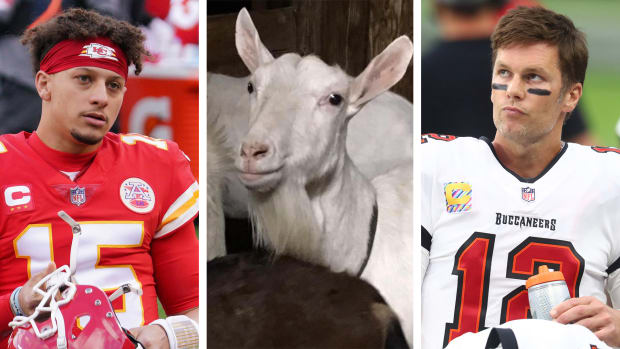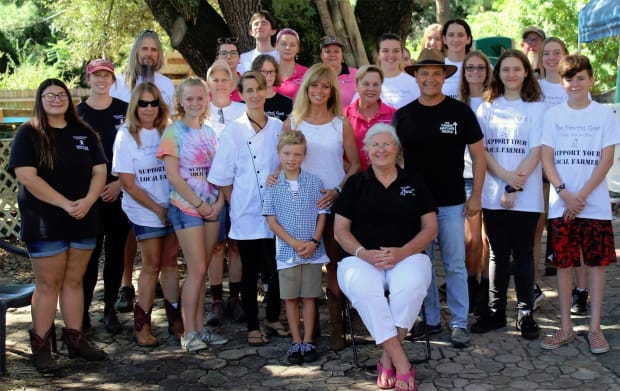How much do championship-winning goats and championship-winning GOATs have in common? After talking to an expert, more than you might think.
When it comes to competition, here’s one thing about goats (not GOATS, the
commonly used acronym for the “greatest of all time”): They start out by competing in their own age group, usually in two divisions per show. They’re split into juniors, which are generally goats under two years old who are not yet being milked, and seniors, who must have been bred at least once and produce milk for commercial farms, like The Dancing Goat in Tampa. The seniors, like football players, can compete as long as they’re able to.When any one of these animals wins any particular competition—think goat versions of the Westminster dog show—they move through what is essentially the goat playoffs, into the Senior Grand or Junior Grand or Reserve Grand competition for each breed. Once those are settled, the advancing goats (again, not GOATS) come back for BDIS, the acronym for Best Doe in Show. Junior goats are usually favored in the final showcase, because they’re younger, more spry—not unlike athletes in terms of how they age. Those goats are called kids. But when an older goat wins BDIS, taking the goat Super Bowl, owners are even more proud, because that means a senior goat has demonstrated that she can carry multiple pregnancies and lactations yet remain in top condition to compete against goats half her age.
These goats? They’re called Grand Champions.
Which is funny, right? In sports, the greatest athletes ever (think Muhammad Ali, Wayne Gretzky, Serena Williams, Michael Jordan and, of course, Tom Brady) are referred to as GOATS. But actual goats, the lactating kind that compete in these shows, they're GCs. They might as well be called Tom Brady, since he’s the most grand champion in modern sports.

Is all this a bit of a stretch, with the Super Bowl in Tampa fast approaching? Patrick Mahomes, a GOAT in training who plays for Kansas City, will face Brady, the GOAT of all GOATS, and his Buccaneers in Super Bowl LV next week. Probably a reach. Of course, a strange comparison. But think about it. There are two quarterbacks now firmly entrenched in the GOAT life, at roughly the same ages and with roughly the same résumés as their real-life goat counterparts. The Kid and the Grand Champion. And that’s why Pam Lunn, owner and operator of the nonprofit, sustainable commercial dairy in Tampa, can’t keep up with the phone calls flooding her business line this week.
Lunn isn’t a huge football fan, but she says anyone who doesn’t know Brady or his animal comparison would need to have lived off the grid for the last decade. In fact, she somehow became aware that she and Brady buy from the same olive oil company. She sends bottles in her holiday gift packs, importing cases from a family farm in Greece. And just when this story could not get any stranger, Lunn says she’s the distributor of that specific olive oil in the Tampa area, meaning that if Brady ever purchased some, he bought from her. “I don’t even turn on the TV,” she says, “except for something special.” Like, well, him.
The goat farm operator came to that business through serendipity. Lunn shut down her transportation company in the fall of 2001, after the Twin Towers fell. With her children enrolled in 4H, the network of youth development centers, she started to think about how she could make their upbringing more wholesome. Pushed by the tragedy, she took the $250,000 in her bank account and started her own dairy. She bought, bred and sold goats, adding more with any profit she could earn, selling “a little milk under the table” at that point. In 2007, she became a legal commercial goat dairy. She worked at a Bradylike pace. “I have three-year-olds and bird feathers,” she told friends.
Eventually, Lunn came to own something like 400 “feathered fowl”—her term. That’s about 300 chickens, 75 goats, plus horses and some alpaca that they rescue and foster as part of the nonprofit. The goats are even guarded by dogs—she has hundreds of those, too—given the large pack of coyotes that roam nearby.
The attorney for the farm? Fred Grady. He now loves goats and GOATs, having spent his life in the mostly tortured existence of Bucs fandom. He met Lunn through Future Farmers of America, which his children joined about 15 years back—when that quarterback named Brady was starting his ring collection in New England.
Lunn taught the FFA kids like Grady’s how to care for goats like GOATs. The animals eat a custom mixed feed, while the company adheres to strict guidelines regarding the goats’ body weight and how much grain to use. (No word on whether these goats consume avocado ice cream.) The animals also gnaw on grass hay, which Lunn describes as high in protein and good for milk production—not unlike the quarterback who subscribes to a mostly plant-based diet. The goats also live in 12-by-12 stalls, with several clustered together inside each, like teammates. They can roam in the stalls or stroll outside in the paddock, like players traversing from the locker room to the practice fields at headquarters for teams. “You’ll see one out there when the sun’s hitting down low,” Lunn says. “They’re like the bathing beauties of the beach.”

As for the competitions, there are eight recognized breeds. Dairy goats, Lunn points out, are different from the meat-producing ones, which tend to be stockier and live shorter lives (think, sadly, offensive or defensive linemen and their shorter careers). Dairy goats are lean, like quarterbacks, or wideouts, with long, elegant necks, and longer, sturdy legs for female goats that will carry multiple pregnancies. “They have to be in top physical condition,” Lunn says. “Kind of like football players.”
Of the eight breeds, Lunn likes LaMancha the best, due to what she calls “long-level lactations” and docile temperaments (think quarterbacks or kickers). Alpines tend to be more feisty, cunning and “crotchety,” willing to pick fights with anybody (think cornerbacks). Saanen generally are snow-white gentle giants that produce tons of milk (think a particular kind of O-lineman). The biggest competition in Florida often takes place, like the next Super Bowl, in Tampa.
For goats (not GOATs), eight-year-olds are considered geriatric. Lunn breeds her goats no more than three times in their lives, to maintain top condition. They’re expected to produce milk for two to six years through superior nutrition (like, say, TB12 meals). One goat, relatively famously, bred until age 9. Her name was Alexis, and she gave birth at age 13, the equivalent of an 80-year-old woman having a baby. A true miracle, Lunn says.
Asked whether that’s the Tom Brady of actual goats, the GOAT of the g-o-a-t set, Lunn laughs at what’s probably a dumb comparison. “There’s been many over the years.” She says that’s because there are multiple breeds, all competing eventually in the BDIS. They, too, collect banners and trophies. Just not the Lombardi kind.
Speaking of, the Bucs fan and goat lawyer with the last name of Grady would love nothing more than for the football franchise in Tampa to win another championship. He’s rooted for the Bucs since 1976, through the winless season, the Steve Spurrier years, the Doug Williams years, the Jon Gruden years. And, now, the GOAT years, which started with Brady’s arrival this offseason. They’ve had a few of those, Grady says, or great players who maybe don’t quite reach that mantle: Lee Roy Selmon, Williams, John Lynch, Warren Sapp. But Brady is something else, another level.
Grand Champion, more or less.
When the Bucs signed Brady, beating out a host of other suitors, Grady made the GOAT-goat connection. He also knew that Tampa would host the Super Bowl, and he began to wonder. Could it really happen? To his team?
The locals will benefit from the first home Super Bowl in NFL history. That includes Lunn and her goat dairy. This summer, as the pandemic raged, her sales dropped roughly 35%. Her expenses—$8,000 a month to run the farm, $4,000 just to feed the animals—didn’t change a bit. She pumped everything she had back into her business. She got one of the small-business assistance loans. She had already almost shuttered in 2019 and now worries every day about survival. But the attention that her goat dairy has received from the spotlight on the GOAT and his 10th Super Bowl appearance might save her entire operation, Lunn says.
One TV network even wants her to take some goats to the game, bringing together goats and GOATs once and for all.

0 Comments:
Post a Comment